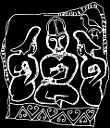
Transoxiana 14
Agosto 2009
Index 14
ISSN 1666-7050


|
Transoxiana 14  |
During field leveling survey in the vicinity of Shymkent in 2008 the bronze cast cauldron together with gilt torque was chanced upon1. These two artifacts seem interesting for the study of the history of this region.
The torque is apparently made of a single smooth copper rod coated with gold sheet. A rod is 4mm thick in the middle and 2mm - at the ends. Diameter of a torque with closed ends makes 14,5см. A clasp is made in the shape of a hook, which is a continuation of one of the extended rod terminals of polyhedron shape with no clear-cut edge. The other terminal is flattened in the shape of a plate with round hole in the centre to hook the torque. We failed to restore the shape of a plate, as a good part of it is broken off. The torque weight is 44,2gr (Fig. 1/1).
Similar torques are found mainly in the European part of Eurasian continent, Thus, similar torque made of pure gold is exposited in the Museum of Historical Treasures of Ukraine in Kiev (No. DM-1635). Date and provenance of it remains an open question, however it has practically identically shaped clasp with one terminal made in the shape of a hook and the other - flattened with round hole in the center. A pendant is made in the form of a gold ball decorated with various geometric patterns (triangles, circles) executed in granulation2. The torque has no parallel in Scythian and Sarmatian antiquities. However a boll pendant looks very much like the balls of the temporal pendants decorated with geometrical pattern executed in granulation dated back to the 7th century A.D. discovered in Ukraine too3. Practically identical artifact was found in tomb 237, burial mound of Romonya I dated back to the end of the 7th century A.D.4
The cauldron is extant only in semispherical body heavily deformed most probably by bulldozer blade (Fig. 1/2). Some fragments of cauldron are missing and those extant are heavily indented. The wall of the cauldron is 1 – 2 mm thick. Apparently, the cauldron had a conical base, which is missing, but we may trace circular (4 cm in diameter) joint line of cauldron base and the wall. The artifact is bronze- cast of a reddish hue. During its casting (or lifetime?) the cauldron was cracked at the bottom and then healed. Similar defect is found on the shoulder of cauldron.
The cauldron body is of flattened semispherical shape with bent post-forged thin rim. Diameter of the rim is approximately 32-34 cm; height of the body is 15-17 cm. The cauldron is embossed with a piece of twisted cord ("string") pattern around the maximum 4,5sm diameter of the body below the rim. At a small distance above the pattern there are two ribbed loop-shaped handles placed opposite each other with triple-projection welded at an angle to the body. Typical casting joints are traced around the foot of handle (Fig. 1/2). The height of handles is 4,3-4cm, and distance between their foot is 4 cm. The rim of the cauldron is smoothly bent and, apparently, post-forged. External surface of the cauldron is covered with abrupt relief grooving diverging in parallel from the bottom to the rim of the cauldron. The surface inside the cauldron is smooth. Judging from visual examination, the cauldron is solid-cast, i.e. the body, handles and bottom were cast in one casting mold.
Bronze cauldron is rather rare in occurrence in Central Asia and Kazakhstan. The most similar artifacts come from the settlement of Gardani Hisor (Tajikistan), which yielded a large fragment of solid –cast cauldron similar to that of the Shymkent city by a number of parameters. It was found on the floor of the premise, which is dated back to the 7th – early 8th centuries A.D judging by ceramic and coin material found in it5. A number of fragments of clay cauldrons dated to the 7th-8th centuries, having also semispherical body and horizontally placed loop-shaped triple-projection handles similar to those of the Shymkent cauldron are common in Ak-Tobe I, Kyrgyzstan6.
At the same time the Shymkent cauldron has a number of morphological and technological parameters, which make it similar to the Scythian and Ujsun cauldrons cast earlier, in the 5th-1st centuries B.C., and Sarmatian cauldrons dated back to the 2nd century B.C. – mid of the 3rd century A.D. However the rims of the Scythian and Sarmatian cauldrons have never been post-forged. Vertical parallel grooving – traces of plant construction preventing cast and burnt working model from damage while molding in clay7 – were found on the surface of both Sarmatian and some Scythian cauldrons as well as on the surface of the cauldron under review. Horizontally placed handles are commonly found on the bronze cauldrons of the early Iron Age in Kazakhstan and Kyrgyzstan8. In the meantime horizontally placed handles have been prevailing for rather limited period of time (over the last centuries BC) and were affected according to the researchers by the Oriental influence9. Sarmatian cauldrons embossed with single string pattern were also widely spread in the 2nd century B.C. – mid of the 3rd century A.D.
Judging by similarity and difference in both morphological and technological parameters we may assume that provenance of the cauldron under review is vicinity of Shymkent. As can be seen from the above it may be safely suggested that the site, where the cauldron and the torque were found, dates from the early Turkic age, the 7th century A.D. But in view of the fact that such artifacts (cauldrons, torques) are uncommon in Syr-Darya region of Kanguj times and poorly classified by date, we may not exclude the possibility of dating this site to an earlier period.
Right in the middle between the handles a small tamgha-like symbol is engraved on the inner surface of the bent rim (Fig. 2/а; 3). The symbol has dimensions of 18 х 20mm. Tamgha consists of an oval-shaped element in the center with unclosed ends slightly curved inward and one line smoothly curved at the terminal upwards. Two symmetrical lines are curved downwards, the right curve is twisted, and twisting of the left is not shown may be because this part of the curve is depicted on the sharply bent edge surface.
Appearance of tamgha especially on the rim of a bronze cauldron is generally related to the role of cauldrons in culture and essentially in ideology of the ancient "nomadic peoples". In addition, this tamgha has an obvious relation to tamghas engraved on the most ancient group of "early Chach" coins, on which they have the attributes of a "dynasty emblem" of the "ruler of the Chachan people (community?)"10, who governed in the ancient Tashkent region. The scholars late back stamping of coins with such tamgha in the Chachan/Chach region to the period from the end of the 3rd to the beginning of the 6th centuries AD.11 Such tamgha is also found on the ancient coins of Sogd (from the second half of the 2nd century BC.) and Khorasmia / Kwaresm (from the 1st century BC)12. It should be noted that graphic design of this mark is so distinctive that there is none perfectly similar to it found even in a representational collection of Caucasian tamghas (1384 marks), many of which according to the reasonable statement of L.I. Lavrov have "genetic relation with Sarmatian marks and Nogai, Tatar and the Central Asian tamghas"13. However similar graphic design appears on all the other marks-tamghas engraved on coins and many other representative property items found in Central Asia.
As is well known, steppe tribes inhabiting the lands of Asiatic Sarmatia14 played a significant role in ethnic origin process of Transoxiana in ancient times. A great number of studies based on written records and archaeological sources deal with the role of Sarmatian tribes in historic development and ethnic and cultural genesis of Transoxiana15. In this line of investigation tamgha-like marks have long been acknowledged to be of special informative value16. It is well known that funeral rites particularly of the Sarmatians, which differ from those, let’s say, of the Saka people, include depositing of cauldrons at the burial place. 20% of all the cauldrons were found in a mound of earth covering the burial place as, probably, in the case with the find under consideration. Sarmatian cauldrons are also distinguished by "tamgha-like" marks cast on the body of cauldron17. Some of these marks are similar or related to symbols on ceramic jars and coins of Transoxiana of Late Antiquity or Early Medddle Ages18. Among the marks that appear on the cauldrons, which, obviously, may be treated as "tamgha-like marks" (Fig. 2/b) there is none quite similar to the tamgha engraved on the early Chachan coins, but from our point of view there is a certain relationship between them.
It has long been acknowledged by the scholars that ("royal", "clan") marks-tamghas used as symbols of power/ownership in the state formations, established by the Sarmatians, have a composite character with the main part being nucleus and complementary elements19. Meanwhile, only complementary elements are subject to variations in number, direction, composition, graphic design and the nucleus/backbone remains unchanged. Marks with unchanged nucleus and varying complementary elements constitute alternating series, the comparative analysis of which may serve as further argument for making some (naturally, hypothetical) conclusions subject to a proper evidence of source studies. In case with "early Chachan tamgha" we may suggest that variations in number and arrangement of curves stand for family/clan division. If we admit existence of some "syntax rules" in formation of a dynasty seal (tamgha) (for instance, symmetry rule), then based on the review of the available variations we may see that these rules limited curves in number from 0 to 4, which could be depicted in ones or twos in upward or downward direction from central element.
Early Chachan / Chach tamgha genetically related to the late Sarmatian seal-tamgha, that we are seeking to establish, represents a composite mark consisting of an oval in the center with unclosed terminals slightly curved inwards (element 1, "ellipsoid") and three lines curved upwards and downwards from the oval. In the summary report of such marks on coins we find a variable series of marks (tamgha) of a family/clan20, which ruled in the early Chachan state (Fig. 4/b) from the end of the 3rd to the beginning of the 6th centuries. Chachan variations include two different positions typical for curved lines depicted above the oval and there appear dots/crosses inside the "ellipsoid", which, apparently, give peculiar attribute to common clan/dynasty seal21. General review of Sarmatian marks22 clearly shows that the curved lines turn out to be the most productive elements in the formation of tamgha (seal), i.e. their variations, probably, were used to identify tamgha (seal) of a smaller division of a tribe (clan or family). Variations of a "Chorasmian Siyavushid" dynasty tamgha differ from each other mainly in the shape of their base having midsection invariable23. We should note that tamgha of the principal Samarkand dynasty was formed following the same pattern, i.e. it has the same complementary elements as Chach tamgha but its midsection is made in the shape of a circle24.
We ought to establish Sarmatian origin of the tamgha under consideration first. For this purpose we have to find its prototypes amongst Sarmatian "tamgha-like marks". It would be correct to review rather representative collection of artifacts, obviously, of Sarmatian origin marked with a series of tamgha -like marks.
These conditions are satisfied by such Sarmatian artifacts as cast bronze cauldrons, which are commonly related to "close" burial complexes predominantly of the elite. We suggest that among the marks on the Sarmatian cauldrons we see tamgha similar to the central element of the Chach tamgha (Fig. 2/b, 12, 18). It is depicted in two positions with unclosed terminals of the "ellipsoid" in upward or downward direction25. Summary report of the late Sarmatian marks – tamghas may be completed with unique tamgha engraved on the gold horse harness, which was discovered on Ilek River, in Pokrovka 2 necropolis (barrow 9). This burial mound is dated back to the second half of the 3rd century A.D.26 Tamgha appears on the square wooden plates covered with gold-foil and it evidently signifies official emblem or tamgha (just as on the coins). Provided that initially only one set of bridle was deposited in the burial, the bridle discovered is marked with three variations of this tamgha varying in the arrangement of two complementary elements – curves (Fig. 4/а, 3-5).
Based on these finds and being very much aware of failure to generate any hypothesis founded on formal coincidence, we may hypothetically reconstruct "line of development" (or "variable series") showing that "early Chach tamgha" is descended from Sarmatian tamgha on bronze cauldrons (Fig. 2/b, 12, 18), via tamgha on Ilek horse harness (Fig. 4/а, 3-5) to seal-tamgha on the early Chach coins of group 1 (Fig. 4/b). Tamgha-like mark on the Shymkent cauldron, probably, is the late specimen of Chachan dynasty tamgha, and its provenance shows habitat area of the clan, of which the above mentioned dynasty is descended from (Fig. 2/а).
Penetration of Sarmatian tamgha alongside with other artifacts and phenomena (such as zoomorphic ceramic ware handles, antropomorphic amulets, mirrors, some types of weapons, etc.) into the culture of Kanguj people living in the middle reaches of Syr-Darya is demonstrated with other marks too. For example, Sarmatian relics of ancient times include objects of (religious) worship marked with an arrow-shaped tamgha (or "bird arm"). Among them is round-shaped altar from Southern Transurals (Chkalov necropolis, barrow 4, grave 3.). Alongside with other marks five arrow-shaped marks are depicted around a circle of the wide altar edge surface (Fig. 5/3). Though the researcher dating this burial back to the beginning of the 4th century B.C., he doesn’t believe that this mark signifies a tamgha27, nevertheless it is important to give a comment on one more Sarmatian bronze cauldron discovered in the Aral Sea region with this mark cast on four sides of its body (Fig. 5/2)28. At the turn of Millennium and in the first half of the I Millennium an "arrow-shaped" mark among others appears on the household ceramic discovered at historical sites of north-eastern Transoxiana29, such mark is cast also on a bronze mirror found in the tomb of necropolis of the ancient town of Sidak (the 6th-8th cc.; district of Turkestan city in South Kazakhstan region) (Fig. 5/1)30.
Thus, hypothesis of a princely birth dynasty of great antiquity ruling in the 4th-5th centuries AD or, probably, even earlier in then urban Tashkent oasis and descending from one of the tribes, created the Late Sarmatian Culture, is in line with ethnic and cultural process going on in the vast area of former powerful Kanguj empire. Apparently, of the same origin was tribal alliance, which the dynasty that settled in Chach was descended from, and the area of its camping-ground included the upper reaches of the Badam, Sajramsu, Kochkarata, Arys’ rivers. In V.Yu. Malashev’ opinion, the native land of the nomadic tribes, created the Late Sarmatian Culture, were semi-deserts of the Central Kazakhstan or steppes of the Northern Kazakhstan31. The artifacts and rituals of their culture are not contradict to this conclusion32. About the middle of the 2nd c. AD these tribes migrated to South Transurals region and very soon – to the west (to steppes of the Lower Volga and Lower Don basins). Later they, probably, penetrated to the south (Syrdarya valley).
B.I. Vainberg restores and gives reason for origin of all the varieties of tamgha of Chzhaovu dynasty of the "house of Yuèzhi", which ruled in Chorasmia, Samarkand and Bukhara Sogd, from tamgha of "Sarmatian" tribes (in the widest sense)33. But it is not important fact for us because the origin of "Early Sarmatians" (mid. 2nd – 1st cc. AD) and the "Late Sarmatians" (mid 2nd – mid 3rd cc. AD) connected with the different groups of Asiatic nomads.
Alimov K.A., Bogomolov G.I., 2000. On the Problem of the Ethno-cultural Contacts of the Nomads of Bukhara and Chach Regions (K voprosu ob etnokul’turnykh kontaktakh kochevnikov Bukhary i Chacha) – History of the Material Culture of Uzbekistan (Istoriya material’noi kul’tury Uzbekistana), Vol. 31, Samarkand.
Boroffka N. and oth., 2005. Ein Kessel aus dem Vorland des Aral-See – Eurasia Antique, Band. 9. Berlin.
Bubnova M.A., 1963. Ak-Tobe I Medieval Settlement near Orlovka Village (Srednevekovoe poselenie Ak-Tobe I u sela Orlovki) - Archaeological Monuments of Talas Valley (Arkheologichskie pamyatniki Talasskoi doliny) (Ed. by N. Kozhemyako). Frunze.
Demidenko S.V., 2008. Bronze cauldrons of the ancient tribes of the Lower Volga region and Southern Transurals (the 5th c. B.C .– the 3rd c. A.D.) (Bronzovye kotly drevnikh plemen Nizhnego Povolzh’ya i Yuzhnogo Priural’ya (V v. do n.e. – III v. n.e.). Moscow.
Demidenko S.V., Demidenko Yu.V. (In print). On the Problem of Interactions of Trans-Volga region, Northern Caspian Sea Coast and Transoxiana in the Last Centuries B.C. (K voprosu o svyazyakh Zavolzh’ya, Severnogo Prikaspiya i Srednei Azii v poslednie veka do nashei ery) (In print).
Dratchuk V.S., 1970. On Tamga-Type Signs Studies of the Porth Pontic Periphery of the Ancient World (Ob issledovanii tamgoobraznykh znakov severopontiiskoi periferii antichnogo mira) – Ancient History Herald (Vestnik drevnei istorii), 1970/4, Moscow.
Dratchuk V.S., 1975. S. Systems of Signs of the Northern Black Sea Coast (Sistemy znakov Severnogo Prichernomor’ya). Kiev.
Filanovitch M.I., 1991. On Interpretation of Burials in the Lower Horizon of Shashtepa in Tashkent (K interpretatsii pogrebenii v nizhnem stroitel’nom gorizonte Shashtepa v Tashkente) - History of the Material Culture of Uzbekistan (Istoriya material’noi kul’tury Uzbekistana), Vol. 25, Tashkent.
Filanovitch M.I., 1999. On the Problem of Migration Routes of the Early Nomads [Chach and Sogd on Route of Nomads to Bactria] (K voprosu o putyakh dvizheniya rannikh nomadov [Chach i Sogd na puti kotchevnikov v Bakrtiyu]) - Study of the Cultural Heritage of the East. Cultural Traditions and Continuity in Development of the Ancient Cultures and Civilizations. Abstracts of the International Conference (Izuchenie kul’turnogo naslediya Vostoka. Kul’turnye traditsii i preemstvennost’ v razvitii drevnikh kul’tur i tsivilizatsii. Materialy mazhdunarodnoi konferentsii). St-Petersburg.
Ilyasov J.Yu., 2007. On origin of tamgha of the Samarkand governors (O proikhozhdenii tamgi samarkandskikh pravitelei) – Abstracts of the International Workshop devoted to 2750 Anniversary of Samarkand (Materialy mezhdunarodnogo seminara, posvyashchennogo 2750-letiyu Samarkanda). Tashkent, Samarkand.
Ilyasov J.Yu., 2009. Nomad Heritage: Kushan Tamgha-Signs from Southern Uzbekistan - Traditional Marking Systems: Presence, Symbolism and Usage (Ed. by J. Evans Pim, O. Perrin, S.A. Yatsenko). London, 2009.
Kiss A., 1977. Avar Cemeteries in County Baranya – Cemeteries of the Avar Period (567-829) in Hungary. Vol. 2. Budapest.
Kuznetsov A.V., 2007. Kuznetsov A.V. Sequence of the Coinage of Some Groups of the Coins of Chach of the 7th-8th centuries (Posledovatel’nost’ vypuska nekotorykh grupp monet Chacha VII-VIII vv.) – Transoxiana – Maverannahr (Ed. by E.V. Rtveladze). Tashkent.
Lavrov L.I., 1978. Historic and Ethnographic Brief History of the Caucasus (Istoriko-etnograficheskie ocherki Kavkaza). Leningrad.
Litvinsky B.A., 1968. Sarmatian and Kang-Ku’ Hvarnah (Sarmatsko-kangyuiskii farn). Dushanbe.
Malashev V.Yu., Yablonsky L.T., 2008. Steppe Population of Southern Transurals in the Late Sarmatian time (Stepnoe naselenie Yuzhnogo Priural’ya v pozdnesarmatskoe vremya). Moscow.
Malashev V.Yu., Moshkova M.G., 2009. Origin of the Late Sarmatian Culture (Statement of a Problem) – Establishing of the Late Sarmatian Culture. Materials of Seminar of the Center of Study of the History and Culture of Sarmatians (Stanovlenie pozdnesarmatskoi kul’tury. Materialy seminara Tsentra izucheniya istorii i kul’tury sarmatov) (Ed. by V.M. Klepikov). Vol. III. Volgograd.
Minasyan R.S., 1986. Bronze Cauldrons Casting of the Eurasia’ Steppe Peoples [the 7th c. B.C. – the 5th c. A.D.] (Lit’e bronzovykh kotlov u narodov stepei Evrazii [VII v. do n.e. – V v. n.e.] - Archaeological Collection of the State Hermitage (Arkheologicheskii sbornik Gosudarstvennogo Ermitazha), Vol. 27. Leningrad.
Obel’tchenko O.V., 1967. Burials of Sarmatian type near Samarkand (Pograbebiya sarmatskogo tipa pod Samarkandom) – Soviet Archaeology (Sovetskaya arkheologiya), 1967/2.
Ol’khovsky V.S., 2001. Tamgha [on Sign Functions] (Tamga [k funktsii znaka]) - Historical and Archaeological Almanac (Istoriko-arkheologitcheskii al’manakh), Vol. 7, Armavir, Moscow.
Rtveladze E.V., 2000. On Early Coins of Chach (Chachan) and on Actual Name of This Region (O rannikh manetakh Chacha [Chachana] i o podlinnom nazvanii etoi oblasti) - Archeology, Numismatics and Epigraphy of the Medieval Transoxiana (Arkheologiya, numizmatika I epigrafika srednevekovoi Srednei Azii) (Ed. by Kh.A. Amirkhanov), Samarkand
Rtveladze E.V., 2006. History and Numismatics of Chach (Istoriya i numizmatika Chacha). Tashkent.
Scythian Gold. Museum of Historic Treasures of Ukraine, 1992. Tokyo.
Shagalov V. D, Kuznetsov A.V., 2006. Catalogue of the Coins of Chach, the 3rd-8th centuries. Tashkent.
Skripkin A.S., 1990. Asiatic Sarmatia (Aziatskaya Sarmatiya). Saratov.
Smagulov E.A., Erzhigitova A.A., 2004. Grave Constructions of Sidak Necropolis (Pogrebal’nye sooruzheniya nekropolya Sidak) - Proceedings of the Ministry of Education and Science, National Academy of Sciences of Kazakhstan Republic (Izvestiya Ministerstva obrazovaniya i nauki, Natsional’noy Akademii Nauk Respubliki Kazakhstan). Social Sciences. 2004/1.
Smaguov E.A., Yatsenko S.A., 2006. Signs and Pictures on the Pottery from Sidak in Middle Syrdarya Region (Znaki i risunki na keramike Sidaka so Sredney Syrdar’i) – Turan-Turkestan: problems of the cultural and historic succession. The Proceedings of the International Conference devoted to the 10th anniversary of Turkestan archaeological expedition (Turan-Turkestan: problemy kul’turno-istoricheskoy preemstvennosti. Materialy mezhdunarodnoy nauchnoy konferentsii, posvyashchennoy 10-letiyu deyatel’nosti Turkestanskoy arkheologicheskoy expeditsii) (Ed. by T. Ryskeldiev). Turkestan.
Solomonik E.I., 1959. Sarmatian Signs of the North Black Sea Region (Sarmatskie znaki Severnogo Prichernomor’ya). Kiev.
Spasskaya E.Yu., 1956. Copper Сauldrons of Early Nomads of Kazakhstan and Kirghizia (Mednye kotly Kazakhstana i Kirgizii) – Memoirs of Alma-Ata State Teachers-training Institute. Human sciences (Uchenye zapiski Alama0atinskogo gosudarstvennogo pedagogitcheskogo institute. Gumanitarnye nauki), Vol. XI/1. Alma-Ata.
Spasskaya E.Yu., 1958. Finds of the Copper Cauldrons in Kazakhstan and Kirghizia (Nakhodki mednykh kotlov v Kazakhstane i Kirgizii) - Memoirs of Alma-Ata State Teachers-training Institute. Social and Political Sciences (Uchenye zapiski Alama0atinskogo gosudarstvennogo pedagogitcheskogo institute. Obshchestvennye i politicheskie nauki), Vol. XV/2. Alma-Ata.
Tolstov S.P., 1947. From Prehistory of Russia [Paleoethnographic Study] (Iz predistorii Rusi [paleoetnographicheskie etyudy]) – Soviet Archaeology (Sovetskaya arkheologiya), Vol. VI-VII.
Tolstov S.P., 1963. Central Asian Scythians in the Light of the Latest Archaeological Discoveries (Tsentral’noaziatskie skify v svete noveishikh arkheologicheskikh otkrytii) - Ancient History Herald (Vestnik drevnei istorii), 1963/2.
Tregubov V.E., 2000. Sarmatian Sacrificial Altars from Museums Collections of Ural Region (Sarmatskie zhertvennye altari iz muxeinykh sobranii Priural’ya) - Cultural Heritage of Steppes of the Northern Eurasia (Kul’turnoe nasledie stepei severnoi Evrazii). Orenburg.
Vainberg B.I., 1977. Coins of the Ancient Chorasmia (Monety drevnego Khorezma). Мoscow.
Vajnberg B.I., 1999. Ethnogeography of Turan in Antiquity (Ethnogeografiya Turana v drevnosti). Мoscow.
Vainberg B.I., Novgorodova E.A., 1976. Notes on Signs and Tamghas of Mongolia (Zametki o znakakh i tamgakh Mongolii) - History and Culture of the Peoples of Transoxiana: the Antiquity and the Middle Ages (Istoriya i kul’tura narodov Sredney Azii: drevnost’ i srednie veka) (Ed. by B.A. Litvinsky). Moscow.
Yablonsky L.T., 2000. Yablonsky L.T. Main Migration Processes in the Southern Aral Sea region in the Early Iron Age (Glavnye migratsionnye protsessy na territorii Yuzhnogo Priural’ya v rannem zheleznom veke) – Lower Volga Archaeological Herald (Nizhnevolzhskii arkheologicheskii vestnik), Vol. 3. Volgograd.
Yablonsky L.T., Devis-Kimball G., Demidenko Yu.V., 1995. Excavation of Pokrovka 1 and Pokrovka 2 Barrow Necropolises in 1994 (Raskopki kurgannykh mogil’nikov Pokrovka 1 i Pokrovka 2 v 1994 godu) – Barrows of the Left Bank of Ilek (Kurgany levoberezh’ya Ileka). Vol. 3 (Ed. by A.V. Shestakova). Moscow.
Yakubov Yu.Ya., 1987. Bronze Medieval Cauldrons of Tajikistan (Bronzovye srednevekovye kotly Tadzhikistana) – Material Culture of Tajikistan (Material’naya kul’tura Tadzhikistana), Vol. 4. Dushanbe.
Yatsenko S.A., 2001. Tamga-Signs of the Iranian Peoples in the Ancient Times and Early Middle Ages (Znaki-tamgi iranoyazychnikh narodov drevnosty i rannego srednevekov'ya). Moscow.
Yatsenko S.A., 2009a. Problems and Methodic of Study of Nishan-Signs of the Ancient and Early Medieval Iranian-Speaking Peoples of Eurasia" - Traditional Marking Systems: Presence, Symbolism and Usage (Ed. by J. Evans Pim, O. Perrin, S.A. Yatsenko). London, 2009.
Yatsenko S.A., 2009b. On Discussion about the Rise of the Ethnic-cultural Unities of the Nomads of Asiatic Sarmatia in the Second Half of the 2nd – First Half of the 3rd cc. AD (K iscussii ob oformlenii etnokul’turnykh obshchnostei kochevnikov Aziatskoi Sarmatii 2-i pol. II – 1-i pol. III vv. n.e.) – Establishing of the Late Sarmatian Culture. Materials of Seminar of the Center of Study of the History and Culture of Sarmatians (Stanovlenie pozdnesarmatskoi kul’tury. Materialy seminara Tsentra izucheniya istorii i kul’tury sarmatov) (Ed. by V.M. Klepikov). Vol. III. Volgograd.
1 . Apparently, mound of earth covering a small barrow abound in the vicinity of the city turned out to be plowed. The find was received by the Regional Museum of Local Lore for expert examination from a local. Unfortunately, there is no any other information concerning its archaeological background.
2 . Scythian Gold 1992. No. №134.
3 . Ibid. Ns. 183, 184.
4 . Kiss 1977, p. 120-121.
5 . Yakubov 1987, p. 135-138, fig. 1-2.
6 . Bubnova 1963, p. 138, fig. 9/11-15.
7 . Minasyan 1986, p. 61-78; Demidenko 2008, p. 27-40.
8 . Spasskaya 1956; 1958.
9 . Demidenko, Demidenko (In print).
10 . Rtveladze 2000, p. 147-149.
11 . Kuznetsov 2007, p. 121.
12 . Vainberg 1977, p. 34-42, 73-74, 76; Yatsenko 2001, fig. 28-29.
13 . Lavrov 1978, p.108-123, pl. 1.
14 . Skripkin 1990, p. 201-208.
15 . See, for example: Tolstov 1963, p. 42-43; Litvinsky 1968; Obel’tchenko 1967, p. 181-187; Filanovitch 1991, p. 77-87; 1999, p.124-125; Alimov, Bogomolov 2000, p. 164-177; Yablonsky 2000, p. 68-73.
16 . See, for example: Tolstov 1947, p. 45-49; Vainberg, Novgorodova 1976, p. 66-75; Ol’khovsky 2001, p. 75-86; Yatsenko 2001; 2009a; Ilyasov 2009.
17 . Demidenko 2008, p. 137, fig. 1; On fig. 2/b tamgha like marks are shown on Sarmatian cauldrons. Marks are grouped by us in graphic -related groups; Ns. preserved according to S.V. Demidenko.
18 . Yatsenko 2001, fig. 27-29.
19 . See, for example: Drachuk 1970, p. 134-147.
20 . Rtveladze 2006; Shagalov, Kuznetsov 2006, p. 291-292.
21 . Asymmetry in the form of the basic Chorasmian tamgha (Т4; Т1-2 and Т4-5), according to B.I.Vainberg, "reflects tamgha belong to different, though also closely related tribes, families or "sub-dynasties": Vainberg 1977, p. 35.
22 . Solomonik 1959; Dratchuk 1975; Yatsenko 2001.
23 . Vainberg 1977, p. 34-38.
24 . Ilyasov 2007, p. 146-149.
25 . Demidenko 2008, p. 137, fig. 1/ 12, 18.
26 . Yablonsky, Devis-Kimball, Demidenko 1995, p. 44, fig. 64, 67; Malashev, Yablonsky 2008, p. 50; Burial has been plundered in an antiquity therefore, now it is impossible to precisely define arrangement of plates on horse harness; it is impossible to identify how many harnesses were buried in a barrow. We have considered it possible to show plates in the table (fig. 4/а), turning them through 180°.
27 . Tregubov 2000, p. 57-72, fig. 1-4.
28 . Boroffka N. and oth. 2005.
29 . Smagulov, Yatsenko 2006.
30 . Smagulov, Erzhigitova 2004. p. 285-302.
31 . Malashev, Moshkova 2009.
32 . Yatsenko 2009b.
33 . Vainberg 1977, p. 42, 77; 1999.
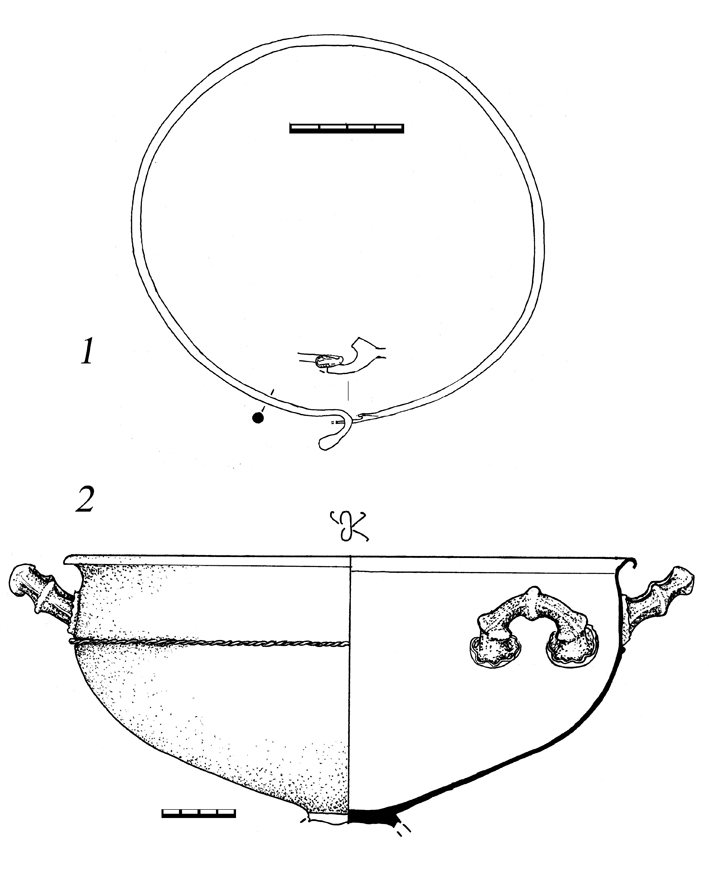
Fig. 1.
Gilt torque and bronze cauldron from the destroyed barrow near
Shymkent, 2008.
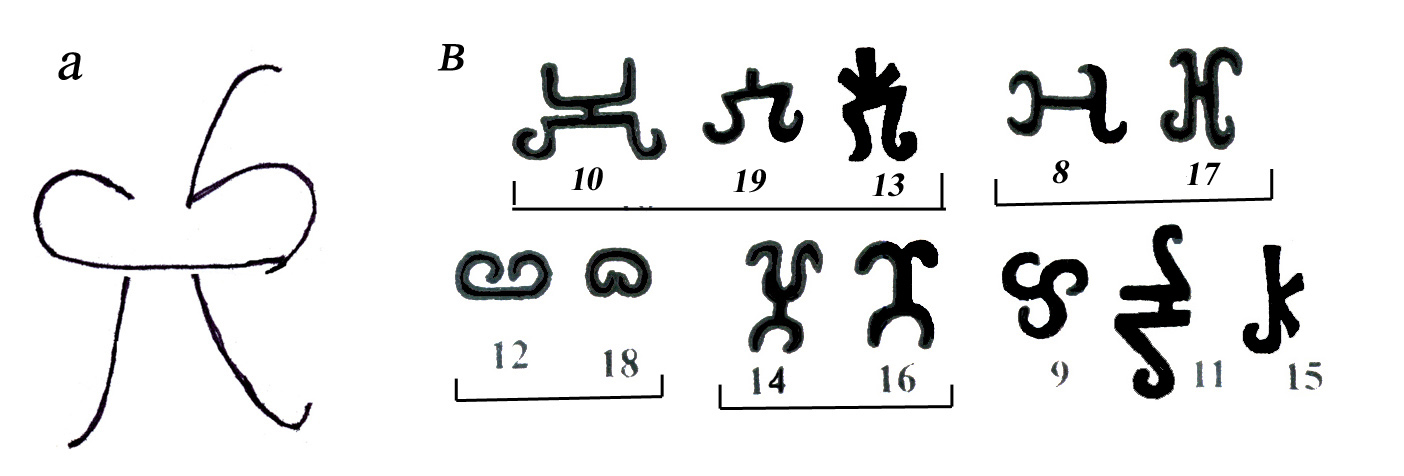
Fig. 2.
Tamga-signs on the cauldrons: a - cauldron rim, the barrow near
Shymkent, 2008; b - Sarmatian cauldrons (Demidenko 2008).
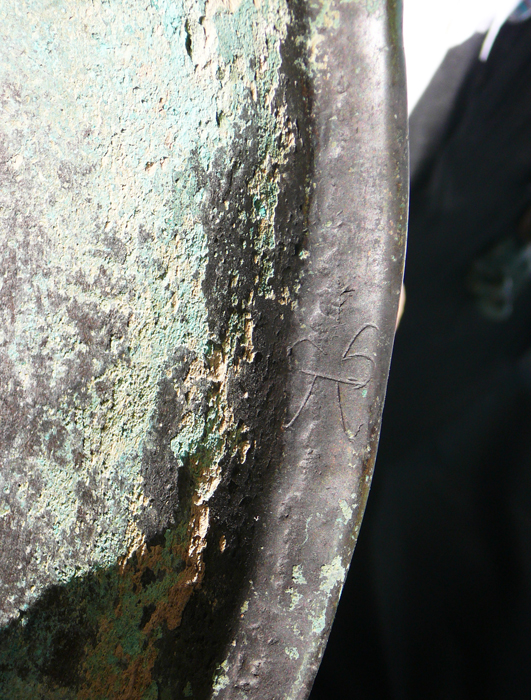
Fig. 3.
Clan/family
sign on rim of the cauldron from the barrow near Shymkent (photo of
Sergey A. Yatsenko, 2008).
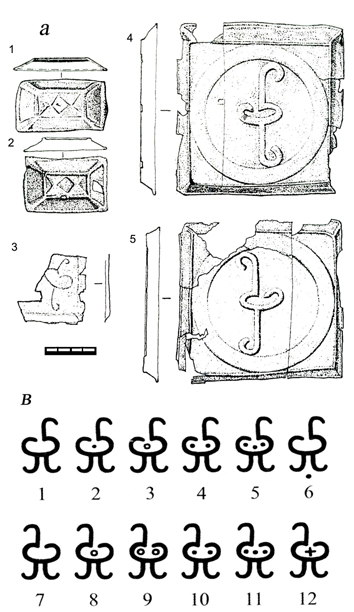
Fig. 4.
Tamga-signs on various artifacts: a – horse harness plates from
barrow 9 of burial ground Pokrovka 2 (according to Malashev,
Yablonsky, 2008); b – early Chach coins of group 1 (Shagalov,
Kuznetsov 2006).
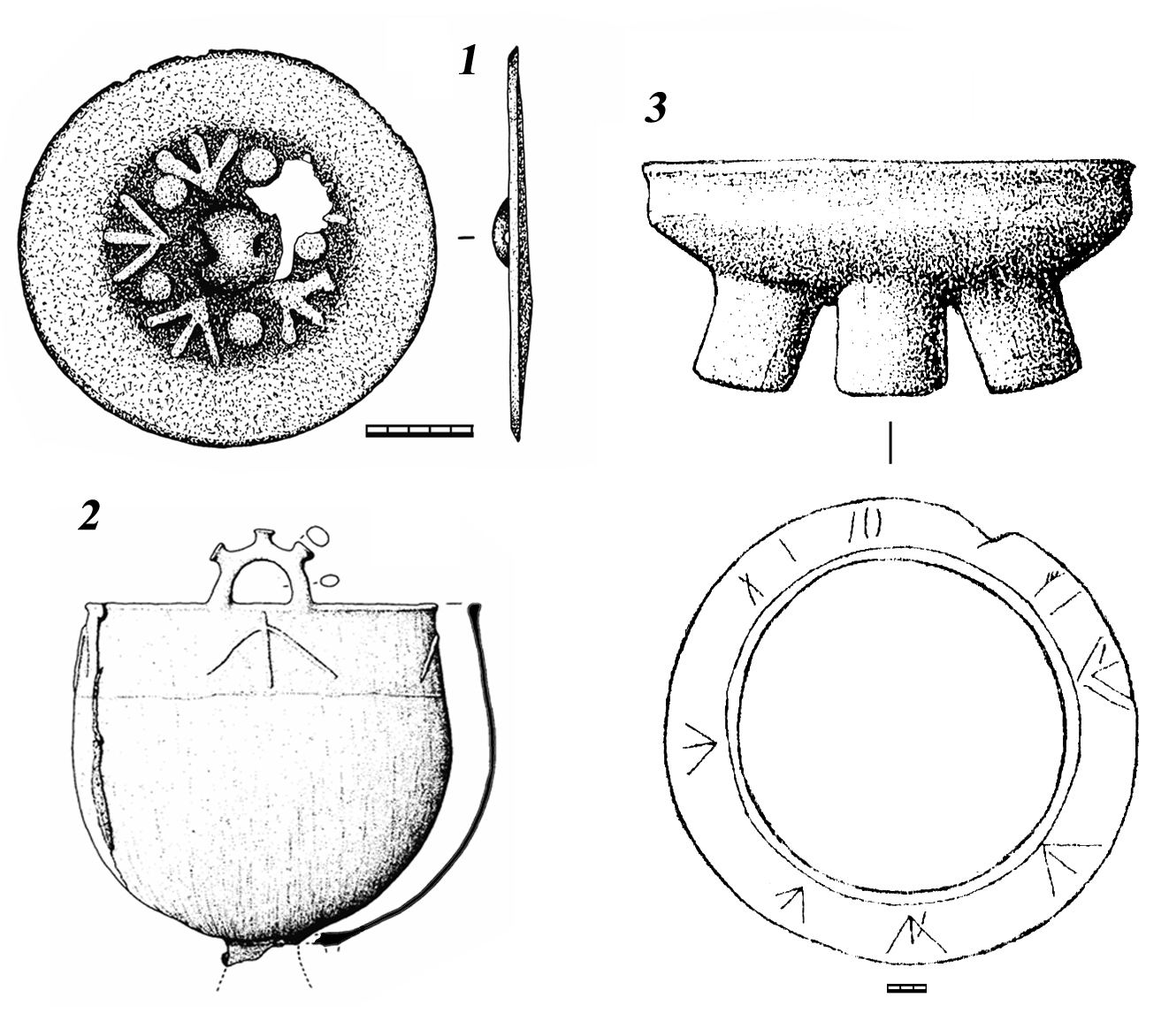
Fig. 5.
Sign of "bird paw" – type: 1- bronze cast mirror from tomb 1
of necropolis of the ancient city of Sidak; 2 - bronze cauldron from
the Museum in Aral’sk (Boroffka and oth. 2005); 3 - Sarmatian
altar from Southern Transurals (Tregubov 2000).
Dr.
Erbulat A. Smagulov,
Institute
of Archaeology, National Academy of Science of Kazakhstan, Almaty,
Kazakhstan.
e-mail:
azret_sultan@mail.ru
Dr. Sergey
V. Demidenko,
Scythian-Sarmatian
Department,
Institute of Archaeology, Russian Academy of Science, Moscow,
Russia.
Aisulu
A. Erzhigitova,
Southern
Kazakhstan Regional Museum, Shymkent, Kazakhstan.
e-mail:
aisulu6767@mail.ru
 © The Author(s) -- Los artículos son propiedad de sus autores. (Ley 11.723 de la Republica Argentina)
© The Author(s) -- Los artículos son propiedad de sus autores. (Ley 11.723 de la Republica Argentina)